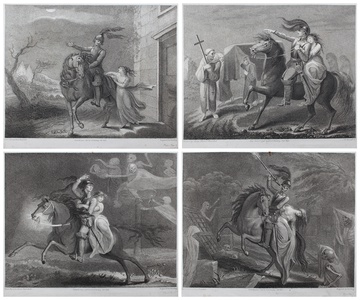| Method | Stipple |
| Artist | Edward Harding and Andrew Birrell after Lady Diana Beauclerk |
| Published | Drawn by Lady Diana Beauclerk. Engraved By Harding/A. Birrell Sc. Publish'd June 1, 1796. by E & S Harding Pall Mall. |
| Dimensions | Images ~228 x 295 mm, Sheets ~257 x 363 mm |
| Notes |
A complete set of four plates from the first 1796 printing of William Robert Spencer's Leonora, an English translation of the popular German gothic ballad Lenore, by Gottfried August Bürger. The poem, first published by Bürger in the 1774 Göttinger Musenalmanach, became a seminal piece of German romanticism, gaining popularity in England through numerous translations, and today seen as an important forerunner to vampiric literature. Spencer's translation was accompanied in its first edition by a set of four illustrations by his Aunt, Lady Diana Beauclerc, as well as a frontispiece engraved by Bartolozzi, though a new edition printed later in the year replaced these with illustrations by William Blake. In content, the poem shares similarities with other folk tales involving ghostly lovers, notably the Suffolk Miracle from the Roud Folk Song Index. Lenore, who in translation is often called Leonora or Eleanor, is a young woman whose lover, a soldier in the army of King Frederick, has been called away to the Seven Years War. Despite the return of other soldiers to her village from the Battle of Prague, there has been no sign of her paramour. Lenore, in her angst, calls out in anger at God, an act of blasphemy for which she will soon be punished. In the dead of night, her lover appears, mounted on a black charger and asking her to accompany him on a midnight ride. As they ride towards her promised nuptial bed, a funerary train looms from the darkness. Soon, the bridegroom turns his spurs to the horse, and they fly through the night, with Lenore growing more concerned by the blasted landscape and the spectres of the dead that seem to pursue them. In the final scene, as dawn breaks, the terrified girl watches as her lover is revealed to be the skeletal form of Death, and their marriage bed the cold of the grave. Lady Diana Beauclerk (1734 - 1808) was a British amateur artist and illustrator. She was the daughter of Charles, 2nd Duke of Marlborough. She was married to Viscount Bolingbroke and then later Topham Beauclerk. She produced illustrations for two books 1796/7, and designed bas reliefs for Wedgwood. Edward Harding (1776-1796) was a British stipple engraver born in London. The eldest son of Silvester Harding, artist, printseller, and publisher, hedied at the age of 20. Andrew Birrell (c. 1744- c. 1816) British stipple and line engraver possibly originally from Scotland. Birrell was in London by August 15, 1785. He worked extensively for S & H Harding. Condition: Some surface dirt and light foxing to margins. Plate 1: Short tear in upper left margin not affecting the image. Plate 2: Iron stain top middle margin and just into image. Plate 3: Iron stain top middle margin and just into image. Plate 4: Iron stain top middle margin and just into image. |
| Framing | mounted |
| Price | £500.00 |
| Stock ID | 51339 |

